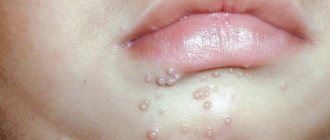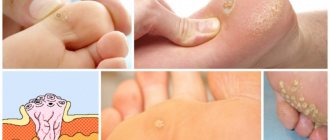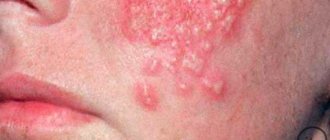Why do papillomas appear on the tongue in the throat?
The reason for the appearance of papillomas on the human body, including mucous membranes, is the penetration of papillomavirus into tissues and blood. Typically, infection occurs through unprotected sexual contact, as well as in everyday life when sharing objects with an infected person. The easiest way for the virus to enter the body is through damaged skin or mucous membranes. It penetrates into the DNA structure and begins to affect the process of cell division. This is how characteristic benign growths appear.
Most often, neoplasms on the mucous membrane of the mouth, throat, including the tongue, appear due to oral sexual contact in adults or through the use of contaminated hygiene items and utensils among children. Also, sometimes the virus can be transmitted from mother to baby during childbirth. However, it is worth noting that papillomas on the uvula in the throat are quite rare, since this organ is difficult to injure and is well protected. However, with an increase in the viral load on the body and the growth of papillomas in the oral cavity or throat, tonsils, growths can also affect the tongue.
The causes of papillomas on the tongue in the throat are common: decreased immunity, chronic diseases, poor diet, hypothermia, nervous strain, overwork, bad habits. All these factors contribute to the activation of HPV and an increase in the number of viral tumors on the mucous membranes.
Preventive measures
Not everyone knows whether they have HPV in their body, so some recommendations should help avoid getting sick and infecting loved ones with the virus. Compliance with hygiene rules is of particular importance:
- Be sure to use your own personal towel; try to be careful in public places, use disposable napkins and paper towels;
- Keep your sex life clean, remember that a condom does not completely protect against this virus;
- Wash your hands thoroughly with soap after going outside, before eating, or contacting animals;
- Adjust your diet - you need more living vitamins, you can also supplement your diet with preparations with minerals and trace elements;
- Drink more clean water, lead an active lifestyle, toughen up.
You shouldn’t be afraid of the appearance of such growths, but you shouldn’t leave everything as is. The sooner you contact a specialist, the faster and more painless the course of therapy will be.
What does papilloma look like under the tongue?
I would like to say right away that these formations do not form immediately, therefore, without professional help at a very early stage, it is unlikely that they will be identified. The virus that promotes the formation of growths under the tongue can “dormant” in the human body not only for months, but also for years. As soon as the most convenient and favorable moment for the virus arrives, it immediately becomes active and manifests itself in the form of growths in certain places. These growths are attached to the surface of the tongue with the help of a “sole” or thin stalk, and they can form not only under the tongue, but also on the tonsils, as well as on the uvula and under the tongue.
Papillary formations can often be found under the tongue, which cause severe discomfort and can make swallowing difficult. Papillomas that form under the tongue can be flat or pointed, and growths of one or the other type can cause trouble. You can see them in the mirror; to do this, you just need to lift your tongue to the sky, at which time you can see the formations in all details.
The pointed growths are small in size and thin in thickness; they look like papillae that constantly cling to the teeth and oral mucosa. Such papillomas are easily damaged and then grow into large lesions. Flat papillomas are more reminiscent of rounded small papules with fairly clear boundaries, and they are attached to the surface of the tongue using a wide “sole”. If you have any suspicions, you need to know which doctor to go to if you have papilloma under the tongue. To start, you can see a therapist. And he, in turn, will direct you where you need to go. This could be a dentist, ENT specialist, dermatovenerologist.
External manifestations (photo)
Growths under the tongue in humans form in the form of warts, papillomas, and condylomas. All varieties are signs of the presence of VPI in the body. Their differences lie in the type of epithelium and external manifestation. Papillomas can be either protruding above the surface of the mucous membrane or flat with rough tissue.
We invite you to read: Rotokan after wisdom tooth removal
Depending on the type and causes of formation, condylomas come in different colors:
- red;
- white;
- light with a yellow tint;
- pink;
- gray;
- from light to dark brown.
Growths in the oral cavity are most often localized in the following areas:
- on the mucous membrane under the tongue;
- on the bridle;
- on the gum under the tongue;
- on the inside of the tongue;
- along the rim of the tongue and other areas of the mucous membrane.
Causes
Any growths on the surface of the tongue or under it may indicate diseases of this organ, systemic infections, or complications of other diseases. Most often, the circumstances that provoke such neoplasms are:
Hypertrophy of the circumvallate papillae.
If a growth on the root of a child’s tongue is observed against the background of tonsillitis, laryngitis, or pharyngitis, we are most likely talking about an increase in the groove-shaped receptors located at the base of this organ.
The cause of hypertrophy is most often an infection of nearby parts - the palatine and pharyngeal tonsils, the mucous membrane of the throat and pharynx. But in some cases their increase can be caused by:
- an allergic reaction to materials used in prosthetics, the manufacture of orthodontic systems, dental fillings, etc.;
- frequent consumption of very hot food or drinks, spicy foods;
- individual intolerance to substances contained in toothpaste, rinses, medicines, food products.
Glossitis.
With inflammation of the tissues of the tongue (glossitis), growths may appear on the tongue closer to the throat, on the surface of the tongue, on its sides - they can be warty, in the form of “camouflage” spots and differ sharply in color from healthy areas. In addition, salivation increases, the sensitivity of taste buds decreases (the child cannot identify the taste of food), difficulties arise with swallowing food or liquid, and with articulation.
Glossitis is almost always associated with an infectious lesion. Pathogens can penetrate the tissues of the tongue through the bloodstream, spread from infected areas of the oral cavity, and enter through wounds formed by burns, chemical or mechanical injuries.
Human papillomavirus (HPV).
This is a systemic infection that develops in all organs and tissues after infection. A characteristic sign of HPV is, among other things, a growth under the tongue of a child, which may look like a cluster of flat warts or pointed formations. The latter option is most often observed.
In this case, the papillomas form even rows at the bottom of the tongue - in appearance they resemble a comb with several teeth. Such growths are caused by genetic abnormalities provoked by the papilloma virus, in which uncontrolled cell division begins.
In addition to this symptom, papillomas in the form of a “necklace” at the base of the neck and a high tendency to colds may be observed. The defining diagnostic criterion is a PCR blood test, which reveals genetic traces of viruses.
Potato juice and herbs
To quickly get rid of growths on the tongue, you need to drink potato juice every day. Potato juice must be made from red potatoes. You should drink at least one glass of this juice per day.
Also a very effective remedy in the fight against growths on the tongue is tincture of rose hips, crushed dandelion or plantain roots.
We invite you to familiarize yourself with What is activation of the brace system
Therapy carried out at home also involves boosting the immune system. To boost your immunity, in parallel with taking appropriate medications prescribed by your doctor, you can also consume various fresh vegetables and fruits.
Pathological conditions
Depending on the cause of damage to organ tissue, diseases are caused by different pathogens. The inflammatory process appears in connection with a traumatic factor and exposure to: bacteria, viruses, fungi. To determine the diagnosis, a visual examination is performed. In some cases, additional research methods are used. These include: smear and biopsy. The formations are located on: the body, side, bottom of the organ. Most patients complain of painful phenomena that occur when touching blisters on the tongue. In addition to pain, other signs of illness are observed. Only a few note that the pathology occurs with a complete absence of symptoms. Diseases accompanied by pathology in the tongue:
Stomatitis. With herpes, the appearance of formations is preceded by deterioration in health, increased temperature, enlarged lymph nodes, and hyperemia of the mucous membrane. A white coating appears on the organ, and salivation increases. Blisters on the tongue appear 2–3 days after the onset of the disease. They are small in size and filled with light liquid. The elements are single or multiple, arranged randomly and localized not only on the organ, but also on the mucous membrane of the inside of the lips and cheeks. Gradually, the liquid in the small balls becomes cloudy, they burst, leaving behind ulcers. With adequate treatment, recovery occurs after 7–14 days. Herpes stomatitis affects adults and children and is contagious. Can recur and be repeated countless times.
The aphthous form of the disease is characterized by the appearance of painful oval-shaped formations;
With candida stomatitis, the foci of infection are localized. They have an oval or round shape, covered with a white coating.
Lichen planus. Women are more often affected by the disease. The main symptom is damage to the mucous membranes. A network of grayish-white papules appears in the oral cavity. The mucous membrane is swollen and painful. There are papules covered with scales on the lips. Bubble formations are observed on the back of the tongue. Initially they look like light nodules, later they transform into red blisters and reach 5 mm in diameter. The blisters ulcerate, leaving behind bleeding sores. The diagnosis is made during a dental examination. If there are characteristic rashes on the body, the pathology is determined by a dermatologist
It is important to carry out differential diagnosis and distinguish lichen from herpes stomatitis; Allergy. Develops due to the presence of a specific agent, which leads to the appearance of corresponding formations
Development factors are considered: hygiene products, food, dental materials, orthopedic structures, alcoholic beverages, tobacco products; Glossitis. The ulcerative-necrotic form of manifestation is accompanied by the appearance of inflammatory areas in the mouth. The formations bleed and ulcerate. The patient’s condition worsens, vital functions are disrupted, eating becomes difficult due to pain; Viral diseases.
- With rubella, together with the presence of elements on the body, rashes appear in the oral cavity.
- Chicken pox is accompanied by the appearance of a small, watery rash. The phenomena are accompanied by itching and pain.
- During scarlet fever, filiform papillae almost disappear, fungiform papillae swell and increase in size. Due to the fact that the organ visually resembles a raspberry, it is called crimson.
Oncological neoplasms. Initially, the superficial lesion is minor and rarely causes pain. The pathology spreads quickly and is accompanied by metastasis.
Quite often, blisters in the mouth on the organ mucosa are formed as a result of mechanical trauma, burns with acids and alkalis. When the first symptoms of pathology develop, consult a doctor to clarify the diagnosis. Waiting for a long time will not solve the situation, but will make the problem worse.
Symptoms of glossitis
A person feels a burning sensation on the tongue, inflammation appears. The tongue becomes burgundy or bright red. If anemia is also present, the tongue becomes covered with a white coating, making it appear pale. The tongue becomes soft and can significantly increase in size. A person observes changes in speech, chewing, and swallowing. If these symptoms appear or at least one of them does not go away within 24 hours, you should immediately visit a doctor. Specialist help is required when there is difficulty breathing, speaking or swallowing. You need to contact a dentist. Only after examination and tests can an accurate diagnosis be made.
Growth under the tongue in a child and an adult - photo, clinical picture and treatment - Denta-smile
The appearance of any formations on the body always causes discomfort. This is especially true when a pathology such as papilloma on the tongue appears. This benign neoplasm is dangerous, as it can easily be injured during human life, contributing to the appearance of wounds and cracks through which infection can enter the body.
Papilloma in this place is formed from cells of the mucous membrane, most often it is observed in women. It is not difficult to detect growths; it is much more difficult to get rid of them.
Branches appeared under the tongue
Papillomas on the tongue are formed in the form of growths and processes on the surface of the mucous membrane of this organ, which are formed as a result of infection of the oral cavity with the human papillomavirus.
Causes of growths under the tongue
In the first stages of the development of the disease, the first cone-shaped process appears under the tongue. It interferes with eating and causes discomfort during conversations.
If this condyloma is not removed, then in the future similar warts may appear on the lateral surfaces of the tongue and spread to its root.
This condition of the oral mucosa indicates that the disease is advanced and there is a risk that the lingual papillae will be damaged.
Kinds
A growth can appear anywhere: on the tip, on the side, on top of the hard palate or below on the sublingual area of the tongue.
Formations are rarely observed on the root part. There are two types of protrusions:
- Pointed. This formation has a stalk, is pink in color, and looks like a filiform papilla. Location in the sublingual area. Occurs in 50% of cases.
- Flat. There is also a large percentage of flat, round growths. They are hard to notice because they don’t show themselves much.
If formations appear as a result of stomatitis, a reaction to a drug, microtrauma, then they come in the form of blisters, pimples, etc.
Skin lumps may be round or oval in shape. They bring discomfort, sometimes very painful. They quickly become damaged and interfere with eating or talking. If you do not seek medical help in a timely manner, they can grow and degenerate.
Some neoplasms can threaten human life. Sometimes a tumor on the tongue is a tumor. They are divided into: malignant and benign.
The following types exist:
- Adenoma. Formed on the basis of mucosal glands, it appears on the root and tip of the tongue.
- Papilloma. Formed from flat multilayer epithelium, one or several at once. It has a round or oblong shape and light pink color. The tip of the tongue and its hard palate suffer.
- Fibroma. An elastic round growth, it is based on connective tissue. May have a leg.
- Botriomyxoma. Flat or ball-shaped tumor. The initial shade is red, then it darkens. Grows up to 10 cm. It can be flat or covered with crusts.
- Lipoma. Located under the tongue or at its root. Painless, soft structure, slow growth.
- Retention cyst. Occurs on muscle fibers, under the tongue or near its tip.
- Neurofibroma. The place of localization is the root of the tongue. It develops slowly and is painful.
- Myoma. It is located on the surface of the tongue and has a dense consistency.
- Hemangioma. Appears in the form of red and blue spots. Sometimes they bleed.
- Lymphangioma. Children suffer in the first year of life. The formation forms on the walls of the lymph nodes. Located on top, at the root or near the tip of the tongue.
Only a doctor can determine the type of neoplasm after a complete examination and examination of the patient.
In some cases, a benign tumor develops into cancer.
Removal methods
There are several ways to remove growths under the tongue. In each individual case, the specialist selects the best option, taking into account the localization of the formation and the extent of the affected area. Whatever method is used, it is complemented by antiviral therapy to prevent relapses. Only an integrated approach, including taking medications, will help get rid of the problem in the oral cavity.
| Treatment of growths under the tongue | |
| Method name | Process description |
| Surgical removal | An effective way to remove growth by cutting it off from soft tissue using surgical instruments: scalpel, scissors, electric knife, conchot. Sutures are subsequently placed on the wound. |
| Cryodestruction | The growths are removed using liquid nitrogen. The method copes with the task, but this type of influence can provoke malignancy of the formation, that is, have the opposite effect. |
| Laser removal | The essence of the method is to cut off the growth with a laser beam. The advantages of the method: quick and effective elimination of formations, absence of pain for the patient and bleeding, which prevents infection. The likelihood of relapse is very low; after the procedure, the process of cell regeneration is stimulated. |
| Radio wave therapy | The method is low-traumatic and painless; the procedure does not even require the use of a local anesthetic. Removal of growths occurs under the influence of high frequency radio waves. The specialist directs them to the base of the growth and cuts off the affected tissue. The rehabilitation period lasts 7-10 days. |
| Electrocoagulation | This method efficiently and quickly removes pedunculated growths on the tongue. The essence of the method is to throw a loop of special fiber over the formation and apply high-frequency current to the material. The hot fiber cuts off the growth, simultaneously soldering the microvessels, which prevents bleeding and infection of the wound. Electrocoagulation prevents further development of the virus. At the site of the removed growth, a crust forms, which after some time comes off on its own. |
| Galvanocaustics | The location of the small growth is cauterized with platinum wire heated under the influence of current. The method is fast, eliminating bleeding and infection of the wound. |
Diagnostics
Examination by an otolaryngologist
If characteristic growths are detected in the oral cavity, you should contact one of the recommended specialists (depending on the location of the focal area):
- dentist;
- otolaryngologist;
- dermatovenerologist.
It would also be a good idea to visit an oncologist to rule out the possibility of developing a tumor of malignant origin.
Diagnosis of condylomatosis and other diseases associated with the formation of growths under the tongue consists of the following steps:
- visual examination by a doctor;
- taking anamnesis;
- laboratory research;
- histology.
It is impossible to make a diagnosis on your own in this case. All three salivary glands are susceptible to inflammation. In addition, the disease can affect several glands at the same time. The examination should be carried out by a dentist or therapist. When examining a patient, a doctor can detect pus discharge and establish the exact location of the inflammatory process.
If the inflammation under the tongue is complicated by an abscess, an ultrasound or computed tomography may be needed. Most often, to make a diagnosis, a doctor only needs to examine the patient’s laboratory test results. Cytological examination of saliva allows you to accurately determine which pathogen caused the development of inflammation of the gland.
How to treat geographic tongue
There is no need to treat the tongue itself. First of all, it is necessary to quickly eliminate concomitant diseases. It would not be amiss to resort to the following measures:
Complete exclusion of irritating factors (that is, do not eat too salty, hot, spicy and cold foods). Carrying out sanitation of the oral cavity (that is, curing all diseases of the teeth and gums). The first detection of diseases should be accompanied by alkaline rinsing and applications with anesthetics. Mandatory intake of multivitamin preparations (special attention should be paid to the use of vitamin B). Carrying out therapy that reduces allergic activity. For burning and other unpleasant symptoms, rinse the mouth with an antiseptic (citral solution), apply an oil solution of vitamin A and vitamin E, and take calcium pantothenate (0.2 grams 3 times).
The prognosis for treatment of this disease is favorable.
Geographic tongue is not an independent disease. It only signals serious problems in the body. If a baby or child has such a tongue, then it is necessary to diagnose his body as soon as possible in order to identify the underlying disease.
There are cases when another infection joins the geographic tongue, which causes serious inflammation of the mucous membrane. In this case, antibiotic therapy is indicated.
Often, older people, having discovered similar patterns on their tongue, are convinced that they have cancer. Sometimes, to convince them, the help of a specialist and psychologist is required. It is worth reassuring that geographic tongue is a benign disease. It cannot take a malignant form.
Folk technique
- The first remedy that was used by the people was a decoction of calendula. To prepare it, take the flowers of the plant, pour boiling water over them in a cup, put it on gas and boil for 15 minutes (low heat). Before you start rinsing, the resulting broth is cooled and filtered. The procedure must be carried out at least 5 times a day.
- The second remedy is a decoction of oak bark. It is prepared in the same sequence as the previous decoction. But there is only one difference: the oak decoction is boiled not for 15, but for 30 minutes.
- The third remedy is a herd of chamomile and oak bark. To prepare, you need to take a teaspoon of each component, pour a glass of boiling water and boil. Keep the broth on the fire for 10 to 15 minutes. After removal, cool the product and strain. Rinse more than once a day.
- The fourth remedy is sunflower oil. Before treatment, the oil must be boiled and cooled. Treatment consists of performing baths with its help. The procedure eliminates unpleasant pain and other sensations.
- The fifth remedy is honey. The bee product is useful to dissolve in the mouth. Honey promotes healing and improves immunity.
- The sixth remedy is propolis. The product should be applied to the inflamed areas. Propolis has the same effect as honey.
- The seventh remedy is a mixture of potato and carrot juice, which is used to rinse the mouth.
- The eighth remedy is a decoction of bedstraw. They rinse your mouth with it 6 times a day.
- The ninth remedy is a soda solution and drops of iodine (the proportions are as follows: a glass of water, 0.5 teaspoon of soda, three drops of iodine). Method of treatment: rinsing.
- The tenth remedy is olive oil. The treatment method is the same as for sunflower.
- The eleventh remedy is tea tree oil. This remedy needs to be diluted with other oils (sea buckthorn, olive, vegetable) and lubricate the inflammatory areas of the mucous membrane.
The following plants heal wounds well, fight inflammation and give a deodorizing effect: plantain juice, willow leaves, sea buckthorn juice, aloe and Kalanchoe leaves.
In addition to the treatment methods described above, it is necessary to follow a diet, eliminate irritating factors, take food only at room temperature, and give up bad habits.
Do I need to follow a diet?
Proper nutrition during treatment is the key to a speedy recovery. Food should be well chopped. Excessive chewing movements will only increase pain and irritate the inflamed area of the mucous membrane in the oral cavity. The menu should consist of soups, vegetable and meat purees, and cereals.
Particular attention is paid to the drinking regime. Before starting your meal, you should drink dried fruit compote, fruit drinks or water with lemon juice. This will help stimulate the production of salivary fluid.
We suggest you familiarize yourself with: Cyst of the upper and lower jaw
Removal of papillomas
The main method of removing growths on the tongue is surgical excision. As a rule, after such an operation stitches are applied.
The second removal method involves the use of a laser. This method is performed once and is welcomed in many modern clinics. This procedure is painless and does not cause any discomfort to the patient. Using a sterile laser, the tumor is cauterized. As a rule, there is no bleeding during the procedure. Laser removal of growths on the tongue helps tissues regenerate faster. The swelling goes away quite quickly, and the scar after the operation is practically invisible. This method is very effective, so a repeat procedure is rarely required.
After the operation is completed, the patient is kept within the walls of the medical institution for some time. The specialist should prescribe special medications with an immunostimulating effect. It will also be necessary to take various antiviral drugs in parallel.
The third method of removal is electrocoagulation. This procedure involves cauterization of tumors using special forceps. Electrical impulses are applied to the tips of the forceps.
The fourth removal method is radio wave exposure.
Consider the symptoms of HPV infection
The appearance of a growth on the tongue (photo below) resembles a compaction, tubercle or growth that is located on different sides of the muscle. The shape of the compaction is elliptical or thread-like (there is a thin stalk), the texture is smooth and soft, without flaking.
The color of the defect may completely coincide with the mucous membrane (reddish, pink) or have a whitish tint.
The diameter of the formation ranges from 2 to 20 mm.
Initially, 1-2 papillomas appear, but over time they can form entire lesions
The location of the growths is also known - the back of the muscle, the root, the sides, as well as the mucous membrane underneath it. Sometimes a formation may appear in the palate or in the area of the larynx, which will cause difficulties for surgical removal.
As a rule, 1-2 papillomas initially appear, however, they can quickly develop into entire lesions, especially for the pointed type.
Apart from visual moments, other symptoms do not appear for a long time. Large lesions can cause discomfort during chewing, communication and swallowing. Also, these processes can cause infection or inflammation of the wart, which will additionally cause burning, pain, swelling and bleeding of the formation.
What to do at home if a growth appears - folk methods
| Treatment of growths under the tongue | |
| Method name | Process description |
| Surgical removal | An effective way to remove growth by cutting it off from soft tissue using surgical instruments: scalpel, scissors, electric knife, conchot. Sutures are subsequently placed on the wound. |
| Cryodestruction | The growths are removed using liquid nitrogen. The method copes with the task, but this type of influence can provoke malignancy of the formation, that is, have the opposite effect. |
| Laser removal | The essence of the method is to cut off the growth with a laser beam. The advantages of the method: quick and effective elimination of formations, absence of pain for the patient and bleeding, which prevents infection. The likelihood of relapse is very low; after the procedure, the process of cell regeneration is stimulated. |
| Radio wave therapy | The method is low-traumatic and painless; the procedure does not even require the use of a local anesthetic. Removal of growths occurs under the influence of high frequency radio waves. The specialist directs them to the base of the growth and cuts off the affected tissue. The rehabilitation period lasts 7-10 days. |
| Electrocoagulation | This method efficiently and quickly removes pedunculated growths on the tongue. The essence of the method is to throw a loop of special fiber over the formation and apply high-frequency current to the material. The hot fiber cuts off the growth, simultaneously soldering the microvessels, which prevents bleeding and infection of the wound. Electrocoagulation prevents further development of the virus. At the site of the removed growth, a crust forms, which after some time comes off on its own. |
| Galvanocaustics | The location of the small growth is cauterized with platinum wire heated under the influence of current. The method is fast, eliminating bleeding and infection of the wound. |
In addition to traditional treatment of growths under the tongue, many patients use traditional recipes. It is impossible to replace treatment with a completely unconventional method, but nothing prevents you from trying it.
Popular folk recipes for growths under the tongue:
- daily rubbing of the formations with garlic juice or applying cloves of spice;
- lubricating newly appeared growths with egg white;
- treating affected areas with castor oil (using cotton swabs);
- rinse the mouth twice a day with decoctions of medicinal herbs (medicinal chamomile, string, sage, echinacea, etc.);
- ingesting rosehip decoction, freshly squeezed potato or carrot juice.
Any infections and viruses developing in the body signal a decrease in immunity, so during the treatment period you should take care of taking fresh vegetables and fruits. A good vitamin complex is also suitable for these purposes.
Therapeutic measures
Treatment of papilloma on the tongue should be carried out by highly qualified specialists; in total, several treatment options can be distinguished: conservative, surgical, independent. As for the latter, it is not recommended to rely solely on it, since it is not possible to fight the virus with folk remedies. During this period, it is recommended to strengthen the immune system to help yourself cope with the problem faster.
Conservative measures
If the patient has a papilloma of the second type, that is, flat, surgical intervention is usually not indicated. In this case, several treatment methods can be recommended:
- Interferons are prescribed, which are applied topically to reduce the amount of viral DNA in a specific focus;
- Immunostimulating antiviral drugs are used;
- Oil solutions of vitamin A help well; the neoplasm is regularly lubricated with it throughout the entire treatment period;
- A monthly course of alpha interferon can be prescribed, which is very effective in simple cases.
Separately, it is necessary to discuss the treatment of a pregnant woman, because during this period the body’s defenses are weakened and the disease often manifests itself. Instead of the procedure for removing the formation, the specialist has the right to prescribe special immunostimulating drugs, for example, Kipferon, Reaferon or Viferon.
Such treatment is not always indicated; this method is intended for large growths or for those formations whose constant growth could not be reduced thanks to conservative methods. The essence of the procedure is that first excision is performed, and then galvanocaustics (cauterization). In this case, chemicals are not used, as they can cause an inadequate reaction, even leading to the degeneration of a wart into a malignant formation.
If previously excision with a scalpel was widely used, today the radio wave method is most often used. The previously required area is treated with an anesthetic solution, after which the procedure itself can begin. It is completely painless, and it is not difficult to remove even the smallest warts. There are no side effects; a burning sensation is possible at the treatment site for half an hour after surgery.
Removal using electric current is also effective, but has disadvantages - pain, long recovery period. Cryodestruction (freezing with liquid nitrogen) allows the formation to die off in 7–10 days.
As already mentioned, it is impossible to replace professional therapy with self-medication for this disease, otherwise there are direct risks to human health and life. At the same time, traditional methods can complement the treatment regimen drawn up by a specialist.
Potatoes are used as one of the effective products that can treat warts. Take a few recipes into account:
- Gargling with potato juice. It is necessary to take fruits with red peel, rinse your mouth with liquid for two months every day;
- Potato sprout tincture (with vodka). The area damaged by papillomas is lubricated with the composition until the pain stops.
Also among the folk methods of combating the virus are tinctures of echinacea, rose hips, and decoctions of various herbs (nettle, plantain, horsetail, dandelion root, lemon balm). These drugs are not therapeutic, but prophylactic, and therefore can only be used in conjunction with therapy prescribed by a specialist.
Experts definitely do not recommend the HPV vaccine, because like any vaccine, it has its side effects and contraindications. You must understand that drugs do not cure, but can only reduce the manifestations of the virus. Today, the Gardasil and Cervarix vaccines are used with special organic substances that are designed to stimulate the body's production of antibodies to fight the disease. At the same time, such vaccination can be carried out up to 26 years of age, when it should have the greatest effect, the validity period is 8 years. Meanwhile, a large number of patients have recently refused to undergo such vaccinations due to the opinion that they may not protect, but rather provoke the development of the disease. However, no information about medical research on this issue is provided.
Among the contraindications for vaccination:
- Bleeding gums, some other dental problems;
- Pregnancy, lactation period;
- Taking certain medications.
If after the procedure you experience weakness, dizziness, severe headache, swelling, rash, call an ambulance immediately










